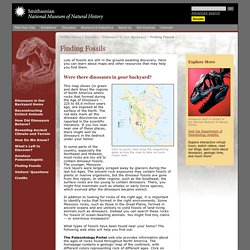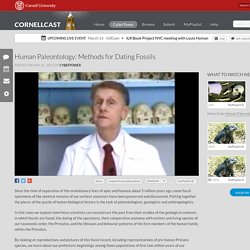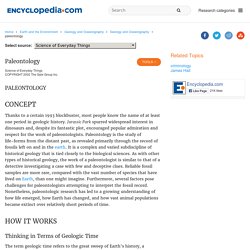

10 Best Recent Dinosaur Discoveries. How to Become a Paleontologist. Smithsonian - Dinosaurs in Our Backyard - Finding Fossils. Lots of fossils are still in the ground awaiting discovery.

Here you can learn about maps and other resources that may help you find them. Were there dinosaurs in your backyard? Click to zoom, then drag the magnifying glass across the map to take an even closer look. This map shows (in green and dark blue) the regions of North America where rocks that formed during the Age of Dinosaurs -- 225 to 65.6 million years ago, are exposed at the surface of the Earth. The red dots mark all the dinosaur discoveries ever reported in the scientific literature. WHAT ARE FOSSILS? 12 Incredible Fossil Discoveries. How Do We Know How Old Fossils Are? 10 INCREDIBLE New Fossil Finds. Paleontology: How reliable is radiocarbon dating? - Quora.
Human Paleontology: Methods for Dating Fossils. We've received your request You will be notified by email when the transcript and captions are available.

The process may take up to 5 business days. Please contact cornellcast@cornell.edu if you have any questions about this request. FOSSILS: how fossils are dated. How Carbon-14 Dating Works. Carbon - A simple PHP API extension for DateTime. The Carbon class is inherited from the PHP DateTime class.

<? Php namespace Carbon; class Carbon extends \DateTime { // code here } Carbon has all of the functions inherited from the base DateTime class. This approach allows you to access the base functionality if you see anything missing in Carbon but is there in DateTime. Definition of Carbon Dating by Merriam-Webster. Does Carbon Dating Prove The Earth Is Millions Of Years Old? Scientific technology. How is carbon dating done? Carbon 14 (C14) is an isotope of carbon with 8 neutrons instead of the more common 6 neutrons.

It is unstable, and scientists know that it radioactively decays by electron emission to Nitrogen 14, with a half life of 5730 years. This means that given a statistically large sample of carbon 14, we know that if we sit it in a box, go away, and come back in 5730 years, half of it will still be carbon 14, and the other half will have decayed. Or in other words, if we have a box, and we don't know how old it is but we know it started with 100 carbon 14 atoms, and we open it and find only 50 carbon 14 atoms and some other stuff, we could say, 'Aha!
It must be 1 carbon 14 half-life (or 5730 years) old.' History - Ancient History in depth: The Story of Carbon Dating. BioMath: Carbon Dating. In this section we will explore the use of carbon dating to determine the age of fossil remains.

Carbon is a key element in biologically important molecules. During the lifetime of an organism, carbon is brought into the cell from the environment in the form of either carbon dioxide or carbon-based food molecules such as glucose; then used to build biologically important molecules such as sugars, proteins, fats, and nucleic acids. These molecules are subsequently incorporated into the cells and tissues that make up living things. Carbon Dating: (How) Does It Work? Important Paleontologists. How to Become a Paleontologist. Paleontologists find, study and connect fossils to the planet's history.

Most work for colleges and universities, museums, government agencies or oil companies. According to the Indiana Department of Natural Resources, most paleontologists have graduate training and jobs typically require at least a Ph.D. Go to College Although paleontologists with only a master's degree might be eligible for certain positions with museums or oil companies, a Ph.D. is typically necessary for most jobs.
What is the salary range of any Paleontologist? Paleontologist Question - Questions & Answers - The Fossil Forum. Suppose a paleontologist discovered a fossil skull that he believes might be distantly related to primates. Unlike true primates, the face is not quite flat and the eyes do not face completely forward. The paleontologist would most likely conclude that th. Paleontology - National Geographic Society. Paleontology is the study of the history of life on Earth as based on fossils.

Fossils are the remains of plants, animals, fungi, bacteria, and single-celled living things that have been replaced by rock material or impressions of organisms preserved in rock. Paleontologists use fossil remains to understand different aspects of extinct and living organisms. Individual fossils may contain information about an organism’s life and environment. Paleontology facts, information, pictures. Science of Everyday Things COPYRIGHT 2002 The Gale Group Inc.

Thanks to a certain 1993 blockbuster, most people know the name of at least one period in geologic history. Jurassic Park spurred widespread interest in dinosaurs and, despite its fantastic plot, encouraged popular admiration and respect for the work of paleontologists. Paleontology. Article about paleontology by The Free Dictionary. Fossil Findings over years. Dating Fossils in the Rocks - National Geographic Society. This diagram shows a selection of rock layers, or stratigraphic columns, from the Koobi Fora geologic formation on the eastern shore of Lake Turkana in Kenya.

This area is a ridge of sedimentary rock where researchers have found more than 10,000 fossils, both human and other hominins, since 1968. These fossils aid the scientific investigation of human evolution. Lake Turkana has a geologic history that favored the preservation of fossils. Scientists suggest that the lake as it appears today has only been around for the past 200,000 years. The current environment around Lake Turkana is very dry. All lakes, rivers, and streams carry sediment such as soil, sand, and volcanic matter.
The area has also been dominated by different landscapes over the span of Turkana’s history—flood plains, forests and grasslands, an active volcano, and lakes. Tectonic activity has had other impacts on research in Koobi Fora region. How do scientists determine the age of dinosaur bones? When paleontologist Mary Schweitzer found soft tissue in a Tyrannosaurus rex fossil, her discovery raised an obvious question -- how the tissue could have survived so long?

The bone was 68 million years old, and conventional wisdom about fossilization is that all soft tissue, from blood to brains, decomposes. Only hard parts, like bones and teeth, can become fossils. But for some people, the discovery raised a different question. How do scientists know the bones are really 68 million years old? Today's knowledge of fossil ages comes primarily from radiometric dating, also known as radioactive dating. Usually, atoms have an equal number of protons and neutrons. The result is like a radioactive clock that ticks away as unstable isotopes decay into stable ones. To read the time on this radioactive clock, scientists use a device called a mass spectrometer to measure the number of parent and daughter atoms. Dating a Fossil - How Carbon-14 Dating Works. As soon as a living organism dies, it stops taking in new carbon.
TRILOBITE. Ch 12 2 pp students. Determining Age of Rocks Fossils.